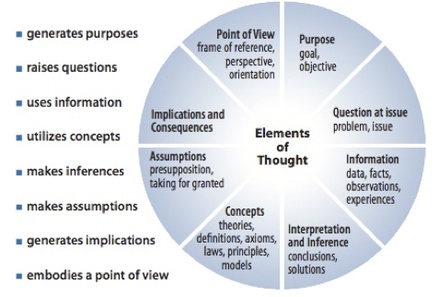PAPER DRAFT SUMMARY REPORTS:
A TWO-STAGE PROCESS
Part I:The summary form is comprised of your responses to a series of questions regarding your draft and is intended to make sure you are considering all the relevant elements of your paper right from the beginning, including your biases, opinions, what theories you are drawing upon and how they influence your interpretations of material evidence. Research has shown that learning to take apart the biases and assumptions on which our interpretations of evidence are based, and that there are eight basic structures - each of which has implications for the others - that make up all our thinking (Foundation for Critical Thinking / www.criticalthinking.org), as presented in the wheel diagram below.
Now that you have written the first draft of your final paper, answer each of the "Elements of Thought" identified in the diagram below. These responses needn't be long - 1-2 paragraphs for each should suffice - but they should critically and thoughtfully address each point. Start with "What is my purpose?" and move around the wheel. Do you find yourself having to change your approach based on your answers to previous or following questions? Your reactions to this summary will direct your revisions of your first draft as you craft your second draft.
Part II: While the responses in the summary report of your first draft were intended to illuminate the foundations of your paper - the structures in place from the beginning, on which you based your research questions, approach, and interpretations - the second draft summary report is intended to help you critically evaluate your paper after it has been substantiated by material and other scholarship, and it consists of your responses to a series of questions addressing your inferences and interpretations.
[reference material from The Thinker’s Guide to Analytic Thinking (2007) / www.criticalthinking.org]
- What conclusions am I coming to?
- Is my inference logical?
- Are there other conclusions I should consider?
- Does this interpretation make sense?
- Does solution necessarily follow from our data?
- How did I reach that conclusion?
- What am I basing my reasoning on?
- Is there an alternative plausible conclusion?
- Given all the facts what is the best possible conclusion?
[reference material from The Thinker’s Guide to Analytic Thinking (2007) / www.criticalthinking.org]

